Deep Sea Arrow Worm


Deep Sea Arrow Worm
Eukrohnia hamata
Arrow worms are small, predatory marine worms that consume copepods, ostracods, and larvae. They resembles a clear, ink pen whizzing through the dark sea. Furthermore, they are found primarily in the Artic Ocean between 700m to 1200m. The picture on the bottom is its head. They have 8 hooks, which are used to grab prey and 25 posterior teeth. Even though the arrow worms are terrifying up close, they are only 4.5 cm in size.
Photo credit: http://www.arcodiv.org/watercolumn/chaetognaths/Eukrohnia_hamata.html
More Posts from Bioluminescentoceangoddess and Others


Pink Helmet
Aglantha digitale
The Pink Helmet is a mini hydromedusa that comes in a variety of vibrant colors. The tiny jelly is only 4 cm in size and is found towards the surface of the ocean. The purple and blue hues we see in its bell are caused by a phenomenon known as iridescence, when light strikes the jelly’s thin tissue at different angles (similar to what we see in a soap bubbles). It also has orange pigmentation near its mouth; this pigmentation helps attract prey and mask luminescence. Furthermore, females tend to be more colorful than males.
Photo credit: https://biolum.eemb.ucsb.edu/organism/pictures/aglantha.html
https://www.pinterest.com/pin/186899453255850798/

Periphyllopsis braueri
The Periphyllopsis braueri is a tiny, deep sea jellyfish that is only 6 cm in diameter. It is red-chocolate in color, and it has eight gonads. Furthermore, it is found at depths between 600m to 1000m.
Photo credit: https://oceanexplorer.noaa.gov/explorations/19gulfofalaska/logs/aug2/aug2.html

Crystal Jellyfish
Aequorea victoria
The Crystal Jellyfish is a graceful, transparent jellyfish with long, thin tentacles. It has bioluminescent organs around it bell that produce a bright, green light. It tends to consume small copepods, but it has the ability to swallow other jellyfish half its size. Furthermore, this jelly is used in biological experiments to detect calcium.
Photo credit: https://www.montereybayaquarium.org/animals/animals-a-to-z/crystal-jelly
https://fineartamerica.com/featured/5-aequorea-crystal-jellyfish-with-amphipods-alexander-semenovscience-photo-library.html
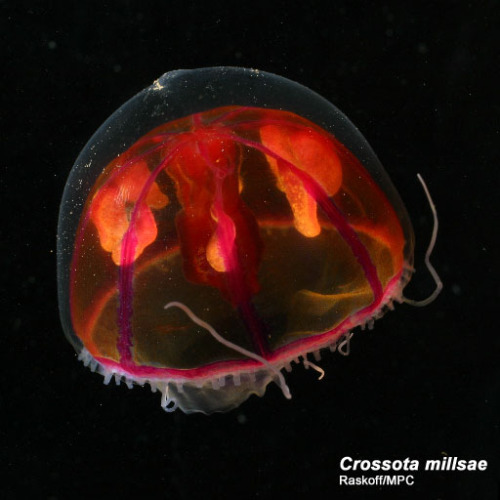
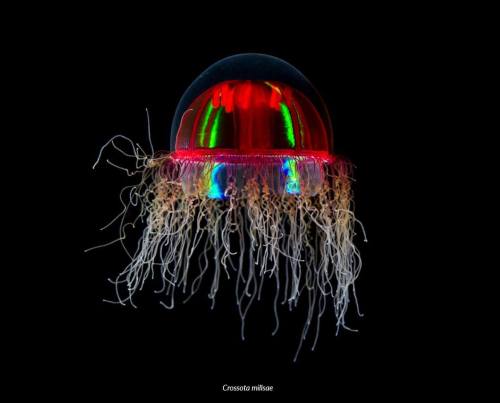
Psychedelic Medusa
Crossota millsae
The Psychedelic Medusa is a deep-sea hydrozoan that is abundant in the North Pacific. The mini-jelly is found at depths between 1000m to 3800m, and are often observed drifting near the ocean floor. It also has an eccentric reproduction behavior uncommon in cnidarians. The females display viviparity, and carry the babies in her bell until they are ready to hatch.
Photo credit: http://www.arcodiv.org/watercolumn/cnidarian/Crossota_millsae.html
https://twitter.com/spothvegr/status/1030177493075079169


Physonect Siphonophore
Nanomia cara
The Physonect siphonophore has tiny, bubble shaped sacs that are filled with gas. The sacs are called pneumatophores and help this creature move through the deep ocean. It also has venomous tentacles that stun prey and over eighty stomachs. There are numerous amounts of these strange creatures along the east coast, and they have cause some fisheries to collapse. Furthermore, they can be found at depth between 400m to 1000m.
Photo credit: http://www.seawater.no/fauna/cnidaria/cara.html
https://www.mindenpictures.com/stock-photo-siphonophore-hydrozoan-cnidarian-nanomia-cara-atlantic-nectophores-naturephotography-image90194961.html
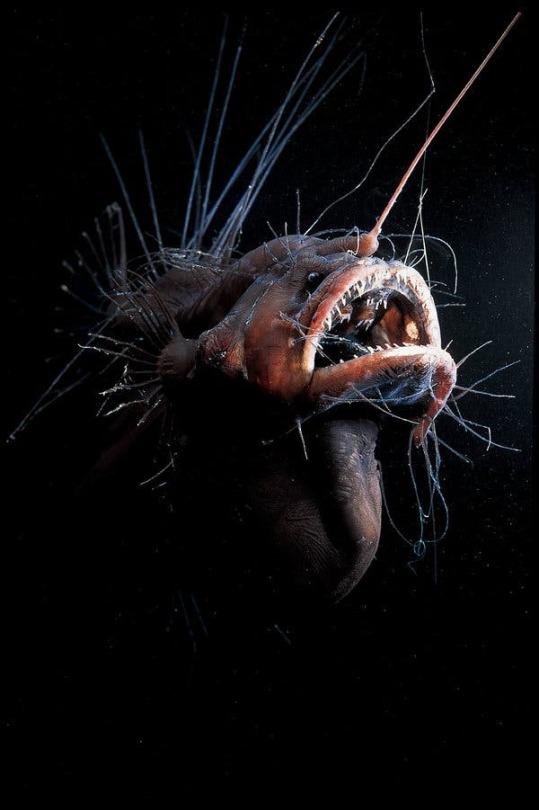
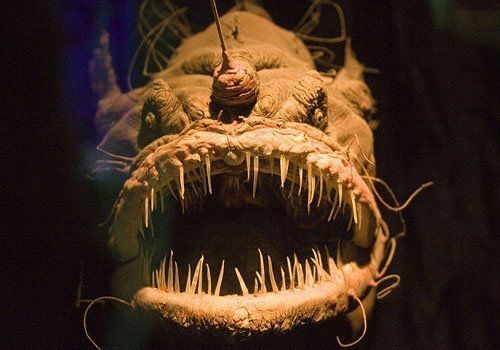
Fanfin Seadevil
Caulophyyne jordani
The Fanfin Seadevil is an ugly, deep fish that is covered in gnarled skin and long sensory filaments. The sensory filaments allow this species of anglerfish to detect movement in the water; this helps the Fanfin find and lure its prey. Furthermore, this deformed monstrosity can be found floating between 700m to 3000m in the ocean.
Photo credit: https://www.nytimes.com/2019/07/29/science/anglerfish-bioluminescence-deep-sea.html
http://www.robotspacebrain.com/alien-creatures-of-the-mariana-trench/


Googly-eyed glass squid
Teuthowenia pellucida
The Googly eyed squid is a rare oddity that is found in the southern hemisphere. It has a large, spherical head that is filled with water and teeny, tiny tentacles that help propel it through the water. If it comes across a predator, it deflates its head and draws its tentacles into its cavity. On the other hand, it may also fill the cavity with water to increase its size, and intimidate the predator. If all fails, it will ink and try to escape through the darkness. Furthermore, baby squids can be found at the surface (0-600m); then slowly migrate downwards as they mature into adults (1600-2500m).
Photo credit: http://animaladay.blogspot.com/2011/07/googly-eyed-glass-squid.html
https://faunafabula.tumblr.com/post/5999675353/googly-eyed-glass-squid-teuthowenia-pellucida
If you are interested in learning about different types of plankton in the ocean, please check out @planktonqueen page. I post a lot of cool species, photos, and facts.

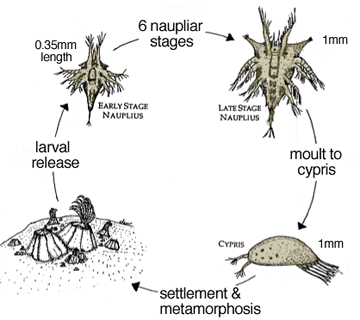
Barnacle Larvae
Amphibalanus eburneus
When we think of barnacles, we think of the hard, white crustaceans that grow on the side of boats and docks. However, barnacles go through a variety life stages and metamorphosis before they spend their life on a hard surface. The image above is a barnacle larvae when it is in the cypris stage, think of it as a baby barnacle. This larvae is an example of zooplankton and spends a short period of time floating around in the water column. The second image summarizes the life cycle of a barnacle.
Photo source: https://www.nyharbornature.com/blog/barnacles-are-reproducing
https://www.pinterest.com/pin/453174781229895797/


Sea elephant
Carinaria japonica
The Sea Elephant is a translucent sea snail that has a large muscular body and a tiny triangular shell. Its foot is used for crawling on the ground, and it can be transformed into a fin that is used for swimming. It is called the “sea elephant” because it has a small trunk in its mouth that is used to swallow prey. Furthermore, the Sea Elephant eats arrow worms and jellies.
Photo credit
https://bodegahead.blogspot.com/2014/12/carinaria-part-2.html
http://tolweb.org/Carinaria_japonica/28750


Gulper Eel
Saccopharynx sp.
The Gulper Eel is known for its massive jaws, which are capable of swallowing prey whole. It’s stomach is also able to expand twice its size. It is found only in the deep see about 2000 to 3000 meters in depth.
Photo credit: https://www.youtube.com/watch?v=XRO0IjSoHGA
https://marinebiochemistrygc2018.weebly.com/deep-sea-adaptations
-
 hiddenlizard reblogged this · 1 year ago
hiddenlizard reblogged this · 1 year ago -
 hiddenlizard liked this · 1 year ago
hiddenlizard liked this · 1 year ago -
 larval reblogged this · 1 year ago
larval reblogged this · 1 year ago -
 larval liked this · 1 year ago
larval liked this · 1 year ago -
 stardustandmoonflowers liked this · 1 year ago
stardustandmoonflowers liked this · 1 year ago -
 barbedwiregirl liked this · 2 years ago
barbedwiregirl liked this · 2 years ago -
 gothfrog-44 liked this · 3 years ago
gothfrog-44 liked this · 3 years ago -
 808beat reblogged this · 3 years ago
808beat reblogged this · 3 years ago -
 808beat liked this · 3 years ago
808beat liked this · 3 years ago -
 larvacea reblogged this · 3 years ago
larvacea reblogged this · 3 years ago -
 windyboysworld liked this · 3 years ago
windyboysworld liked this · 3 years ago -
 chainedchest reblogged this · 3 years ago
chainedchest reblogged this · 3 years ago -
 mr-crix liked this · 3 years ago
mr-crix liked this · 3 years ago -
 leitharstjarna liked this · 3 years ago
leitharstjarna liked this · 3 years ago -
 la-vie-en-lys liked this · 3 years ago
la-vie-en-lys liked this · 3 years ago -
 dr-w0rm liked this · 3 years ago
dr-w0rm liked this · 3 years ago -
 vaguelyexistingcloud liked this · 3 years ago
vaguelyexistingcloud liked this · 3 years ago -
 caime0 liked this · 3 years ago
caime0 liked this · 3 years ago -
 recaisblog liked this · 3 years ago
recaisblog liked this · 3 years ago -
 philargus reblogged this · 3 years ago
philargus reblogged this · 3 years ago -
 dontaskforapplesauce reblogged this · 3 years ago
dontaskforapplesauce reblogged this · 3 years ago -
 dragheadwashereat2019 liked this · 3 years ago
dragheadwashereat2019 liked this · 3 years ago -
 cssanz liked this · 3 years ago
cssanz liked this · 3 years ago -
 rugletthewren liked this · 3 years ago
rugletthewren liked this · 3 years ago -
 ghost-in-a-wasteland liked this · 3 years ago
ghost-in-a-wasteland liked this · 3 years ago -
 feralthot420 liked this · 3 years ago
feralthot420 liked this · 3 years ago -
 afurioustreestudentposts liked this · 3 years ago
afurioustreestudentposts liked this · 3 years ago -
 steffi4chan liked this · 3 years ago
steffi4chan liked this · 3 years ago -
 herd-reject-arts liked this · 3 years ago
herd-reject-arts liked this · 3 years ago -
 moramaisis reblogged this · 3 years ago
moramaisis reblogged this · 3 years ago -
 dimens1ons liked this · 4 years ago
dimens1ons liked this · 4 years ago -
 crystalqueerenby liked this · 4 years ago
crystalqueerenby liked this · 4 years ago -
 13-betelgeuse-0 liked this · 4 years ago
13-betelgeuse-0 liked this · 4 years ago -
 sharkyz liked this · 4 years ago
sharkyz liked this · 4 years ago -
 glittersucker liked this · 4 years ago
glittersucker liked this · 4 years ago -
 theblueeyedfreak reblogged this · 4 years ago
theblueeyedfreak reblogged this · 4 years ago -
 bug-catcher-jecht liked this · 4 years ago
bug-catcher-jecht liked this · 4 years ago -
 quimeral liked this · 4 years ago
quimeral liked this · 4 years ago -
 darkinternalthoughts liked this · 4 years ago
darkinternalthoughts liked this · 4 years ago -
 gmffin liked this · 4 years ago
gmffin liked this · 4 years ago -
 emptybreath reblogged this · 4 years ago
emptybreath reblogged this · 4 years ago -
 emptybreath liked this · 4 years ago
emptybreath liked this · 4 years ago -
 revolupine liked this · 4 years ago
revolupine liked this · 4 years ago -
 narrowland reblogged this · 4 years ago
narrowland reblogged this · 4 years ago -
 narrowland liked this · 4 years ago
narrowland liked this · 4 years ago -
 symbiotic-science reblogged this · 4 years ago
symbiotic-science reblogged this · 4 years ago
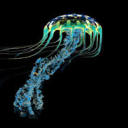
Bioluminescence is a chemical reaction that produces light. Many deep sea animals use bioluminescence. This blog is dedicated to educating the public about the amazing creatures that thrive in the deep sea.
57 posts